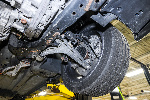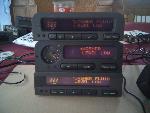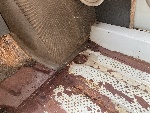
1964-1974 [Subscribe to Daily Digest] |
I compiled a huge "cheat sheet" of Weber tips from various web sources when I was trying to set up my car; here are some of the DGV-specific ones that might help you:
===========================================
<b>Importance of float level</b> (from Pierce - http://www.webercarburetor.com/Float_Level_1.htm)
The float level is a critical part of carburetor calibration. Changing the fuel level in the bowl will change the point that the main circuit starts to feed, alter the characteristics of an emulsion tube, and affect drivability and fuel consumption.
from http://www.carbs.net/Weber/adjust.htm (primarily about progressive carbs, e.g. DGV)
<b>SET UP ADJUSTMENTS</b>
Start set up by confirming carb base line settings. Do not depend on the factory delivered settings. Check them before the carb is installed.
1. All settings are done with choke disengaged or warmed up so that the choke is fully opened and disengaged. This is done on automatic choke carburetors by first opening the choke butterfly by hand and inserting a wood block or wedge of some kind to hold open while the linkage is cycled (linkage operated through its full movement) to clear the choke cam. (You will hear a metallic click as the cam is released. You can check the fast Idle screw under the choke assembly to confirm that it is not in contact with the choke fast idle cam.)
2. Set the Idle stop screw (speed screw see fig 1) by backing out the Idle speed screw until it is not in contact with the throttle stop lever. Cycle the linkage again to be sure that the linkage comes to close without any assistance. (Checking for linkage bind) Now bring screw back into contact with the lever and continue to open or screwing in 1 turn no more than 11/2 turns.
3. Set the mixture screw (see Fig 1) by first screwing in until the screw stops, bottoms out. DO NOT FORCE OR BIND AS THIS WILL CAUSE DAMAGE TO THE SCREW AND ITíS SEAT IN THE BODY OF CARBURETOR. Back out the screw 2 full turns.
4. TUNING - BE SURE TO FOLLOW THE NEXT INSTRUCTIONS IN THE PROPER SEQUENCE, DEVIATION WILL CAUSE THE CARBURETOR TO NOT FUNCTION TO ITS IDEAL SPECIFICATIONS AND MAY NOT PROVIDE THE PERFORMANCE AND FUEL ECONOMY AS DESIGNED.
4a. Start the engine, the engine will run very slowly more like a tractor. As long as the engine stays running, idle speed is not important at this point.
4b. The first thing to do is not set up the idle speed, but to set the idle mixture screw to lean best idle setting. First, turn in the mixture screw until the engine dies or runs worse, then back out the screw (recommend turning ¼ to ½ turn at a time). The engine should pick up speed and begin to smooth out. Back out ½ turn more, or until the screw does nothing or runs worse then turn back to the point where it ran its best. Use your ear, not a scope or tuning instruments at this point. You want to tune the engine by sound. Adjust to best, fastest and smoothest running point.
4c. Now that the mixture screw is at its best running location, you can adjust the idle speed with the screw. The screw will be sensitive and should only take ¼ to ½ turns to achieve the idle speed you like.
Check and set idle to your driving preference. Put the car in gear and apply slight load, (AC on) and set the Idle as you like it. Donít set it too high, as this will cause causes excessive clutch and brake wear. The Idle only needs to be 7 to 900 RPM with light load or AC on.
5. Recheck timing and vacuum hook ups. Recheck mixture screw to lean best idle again. If all is still best and smoothest idle then confirm and note the final settings.
To confirm settings with the engine running. Start by screwing in the mixture screw and count the number of turns it takes to bottom out and note if the engine dies. If Idle Mixture screws are with in ½ turn of base line setting then all is well and have fun. Also check the speed screw and note how many total turns from initial contact. You may have opened (turned in) the speed screw. Your final setting should be under 2 full turns. Reset the screws (back in) to the best final settings (Per your notes) and go on a test drive and have fun. If the settings are other than described then you may want to recalibrate the idle circuit (low speed circuit) to your engines needs. This is done by following the rule of thumb BELOW.
<b>Simple Rules for low speed calibration</b>
If the mixture screw is more than 2-1/2 turns out turns then the idle jet is too lean (too small). When the mixture screw is less than 1-1/2 then the Idle jet is too rich (too large). These assumptions are based on the fact that the speed screw setting is not opened more than 1-1/2 turns. If the speed screw has to be opened 2 or more turns then this is also an indication of a lean condition usually requiring greater change. At times it may appear to be showing signs of richness or flooding it is really a lean condition. Please understand the need to keep throttle plate as near to closed as possible so as not to prematurely expose the transition holes. This is what causes the visible rich condition, and confirms the need to increase the jet size.
EXAMPLE With the speed screw set at no more than two (2) turns in after contact with the stop lever; and the best idle occurring with the mixture screw set at 3 turns from bottom, indicates the need for a larger Idle jet. Achieving the best idle at under 2 turns indicates the need for a smaller idle jet.
The secret to understanding the critical nature of the carburetor set up and the advantages of a WEBER over other carburetors is the idle circuit. Referred to as the low speed circuit by Weber, this circuit is responsible for 80% of the driving operation. This is the reason that the Weber should give a fuel economy improvement over most factory carbs along with significant performance gains. In the worst case you should not see a significant fuel economy loss over stock, while improving HP & Drivability.
The Weber Carburetor is a sequentially timed device to the motor like the distributor. Time taken in the setup will provide more fun later.
<b>GENERAL WEBER THEORY</b> http://dimequarterly.tierranet.com/articles/tech_weber_tuning.html
There is a little theory which will help your appreciation of carburetors. In many ways, fuel-injection systems are simpler devices than carburetors. (You could see carburetors as hydraulic computers while fuel injection is electronic.) The gasoline in the carburetor is not sprayed into the airstream by the fuel pump (that is fuel injection), it is pushed into the low-pressure area created by air flow through the venturis. The fuel pump merely fills a reservoir in the body of the carburetor through the float valve, which stops the flow when the reservoir is full. The trick is to get the fuel into the air reliably, in correct proportions, and in fine liquid droplets like a fog.
An interesting thing is, as air flow slowly increases, as when the engine speed increases and the pistons suck more air through the carburetor, the fuel is willing to flow faster than the air, while during quick changes the air speeds up easier and will flow more than the fuel. The air always needs to flow more, between 11 and 15 times as much air as gas, by weight, is needed for combustion. We have to be clever to get the air and gas mixture just right, by adjusting the flows correctely. Generally, an 11:1 A/F ratio for power and 15:1 for economy are used.
Finally, we can make all of these adjustments with accurately-produced pieces with holes cast and machined to flow as need. As expected, large holes will flow more then smaller ones, but moving them around or changing their edges will also have a large effect on their flow. This last characteristic is what makes the replacement of parts so special with the Weber. All of the Weber parts are labeled for flow, not just hole size. This is also why drilling jets is such a lousy way to tune a carburetor.
The Weber design, like the Hitachis and other downdraft carburetors, breaks the problem of matching air/fuel requirements of an engine into steps, most of which are adjustable. Low flow conditions are handled by the primary (32mm bore/26mm venturi), while high flows are handled by this primary carburetor plus a secondary (36mm bore/27mm venturi) carburetor operating at the same time. This is very similar to the original Hitachi DAF carburetor except the Weber is larger and activates its second half with a mechanical linkage rather than a vacuum mechanism.
The Weber offers a larger variety of tuning parts and is easier to service than the DAF. For the most part, the DAF is simply an old and worn rather than a badly designed or tuned unit. Within each of the twin sections of the carburetor, the fuel and air mixtures are handled by overlapping systems. The idle circuits handle the very low flows which bypass the throttle plate when your foot is entirely off the pedal. As the throttle is opened, the primary enters into play, and the main jet will dominate the tuning effects. When the throttle is fully opened, the air jet will be fine tuning the effects, then the secondary system will come into play in the same fashion. The main fuel jets and air jets both flow into a common tube with a series of mysterious little holes that are called emulsion tubes, or e-tubes, which help turn the "raindrops" of gas into a fog.
The accelerator pump circuit squirts in a little gas when the throttle is quickly opened, to compensate for the air responding quicker than the fuel. The air jet compensates for the increased fuel flow when things settle down. There is also a power-valve jet which drops the 15:1 ratio to 11:1 at WOT to produce full power, and a choke plate for cold starting. Closing off the top of the carburetor increases the suction on the fuel jets and richens the mixture for cold starts. All of this works rather like a band playing music: everything does its job and you hear music. The tuning concept is very much the same as with a band: get each part working in tune with every other part.
[from page 2 of the same article]
Lean will feel like a sudden loss, whereas rich feels like a gradual one, and right on feels very good.
[from page 3 of the same article]
Now you get to make your first guess for improvements. Do everything one-step at a time and test your results. The basic process is to go lean until you know you're too far then back up one jet. You will feel the lean condition much more easily than a rich one. Remember to change only one thing at a time even though I am giving you about ten here. This means you will have lots of fun, and it is also why shops don't sell this procedure, no one wants to pay for the time.
Reassemble and test the car, remembering that lean will surge and rich will lag. You want crisp and happy.
Once you are happy with your primary jetting, you may choose to work on the idle jetting. This is a different technique and doesn't require removing the top of the carburetor, but it doesn't work well until the primary is pretty close. The technique is to drop the idle to a minimum value with the two adjusters (the mixture screw will be about two turns and the throttle screw at the minimum setting) as close to completely shut as possible while still keeping the motor running. You want maybe 750 rpm here. Now, slowly screw in the throttle adjust to speed up the motor to about 1500 rpm and listen to the progression. You want a smooth progression with no surging. A lean mixture may cause stalling. Now return to the low rpm and open the mixture screw 1/2 turn and do the test again. If it improves, then raise the idle jet toÖ the next size. If it deteriorates, drop one jet. Retest.
To repeat, you will find in your experimentation that lean is very easily sensed. You can do a very good job of tuning if you use the technique of going leaner in steps until too lean, then back one step. Smaller mains are leaner, larger airs are leaner. The progression from low throttle up, as you feel it, is idle to e-tube, to main jet, to air jet, and, of course, primary to secondary. The pump and choke circuits are not involved.
Now, if you have the equipment to read the tailpipe you can do a little better in the lean vs. rich sensing. You will be looking for CO readings of 3% to 6% (3% are the best smog value for cruise conditions, and 6% is the best power number for WOT.) Hydrocarbons (HC) under 200 ppm (parts per million) is reasonable with a carburetor tuned for a full power A/F ratio of 11:1 to 12.5:1 for load and 15:1 for cruise, which should work with the above values. Idle screw adjustments are done to minimum C0 and HC readings. 2-5% C0 and 200 ppm HC seem reasonable goals. If the HC level reads above 200 ppm check for a spark miss. For a drag strip type dyno run, one step too lean will cost 0.3 seconds between 3000 and 6000 rpms, while one step too rich will cost 0.1 second. A final note: Altitude corrections are mostly done with the primary main: one size smaller for every 3000 feet.
posted by 68.227.170...
No Site Registration is Required to Post - Site Membership is optional (Member Features List), but helps to keep the site online
for all Saabers. If the site helps you, please consider helping the site by becoming a member.
 |
 |
 |
 |
 |



